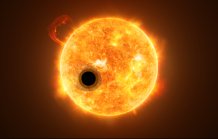articles

The exoplanet WASP-107b is a gas giant, orbiting a highly active K-type main sequence star. The star is about 200 light-years from Earth. Using spectroscopy, scientists were able to find helium in the escaping atmosphere of the planet — the first detection of this element in the atmosphere of an exoplanet. (Photo credit: ESA/Hubble, NASA, M. Kornmesser)
Helium detected in Exoplanet atmosphere for the first time
Astronomers have detected helium in the atmosphere of a planet that orbits a star far beyond our solar system for the very first time.
An international team of researchers, led by Jessica Spake from the University of Exeter, discovered evidence of the inert gas on ‘super-Neptune’ exoplanet WASP-107b, found 200 light years from Earth and in the constellation of Virgo.
The pivotal breakthrough, made from observations of the exoplanet using the Hubble Space Telescope, revealed an abundance of helium in the upper atmosphere of the exoplanet, which was only discovered in 2017.
The strength of the helium signal detected was so large that scientists believe the planet’s upper atmosphere extends tens of thousands of kilometres into space.
Helium is the second most common element in the universe and it has long-since been predicted to be one of the most readily-detectable gases on giant exoplanets. However, this pioneering new research is the first time that the gas has been successfully found.
Now, the research team believe that the ground-breaking study could pave the way for scientists to discover more atmospheres around Earth-sized exoplanets across the galaxy.
The research is published in the leading scientific journal, Nature, on May 3, 2018.
Jessica Spake, part of Exeter’s Physics and Astronomy department said: “We hope to use this technique with the upcoming James Webb Space Telescope, for example, to learn what kind of planets have large envelopes of hydrogen and helium, and how long planets can hold on to their atmospheres. By measuring infrared light, we can see further out into space than if we were using ultraviolet light”
WASP-107b is a very low-density planet similar in size to Jupiter, but with only 12 per cent of its mass. Orbiting its host star every six days, it has one of the coolest atmospheres of any of the exoplanets discovered, although at 500 C is still radically hotter that Earth.
By analysing the spectrum of light passing through the upper part of the exoplanet’s atmosphere, the researchers were able to detect the presence of helium in an excited state.
The significant strength of the signal measured exploited a new technique that doesn’t rely on ultraviolet measurements which have historically been used to study upper exoplanet atmospheres. The team believe this new technique, which uses infrared light, could open up new paths to exploring the atmospheres of more Earth-sized exoplanets found in the further reaches of the universe.
Tom Evans, a co-author also from the University of Exeter added: “The helium we detected extends far out to space as a tenuous cloud surrounding the planet. If smaller, Earth-sized planets have similar helium clouds, this new technique offers an exciting means to study their upper atmospheres in the very near future..”
Helium was first detected as an unknown yellow spectral line signature in sunlight in 1868. Devon-based astronomer Norman Lockyer was the first to propose this line was due to a new element, and named it after the Greek Titan of the Sun, Helios. It has since been discovered to be one of the main constituents of the planets Jupiter and Saturn in our Solar System.
Date: 2 May 2018
